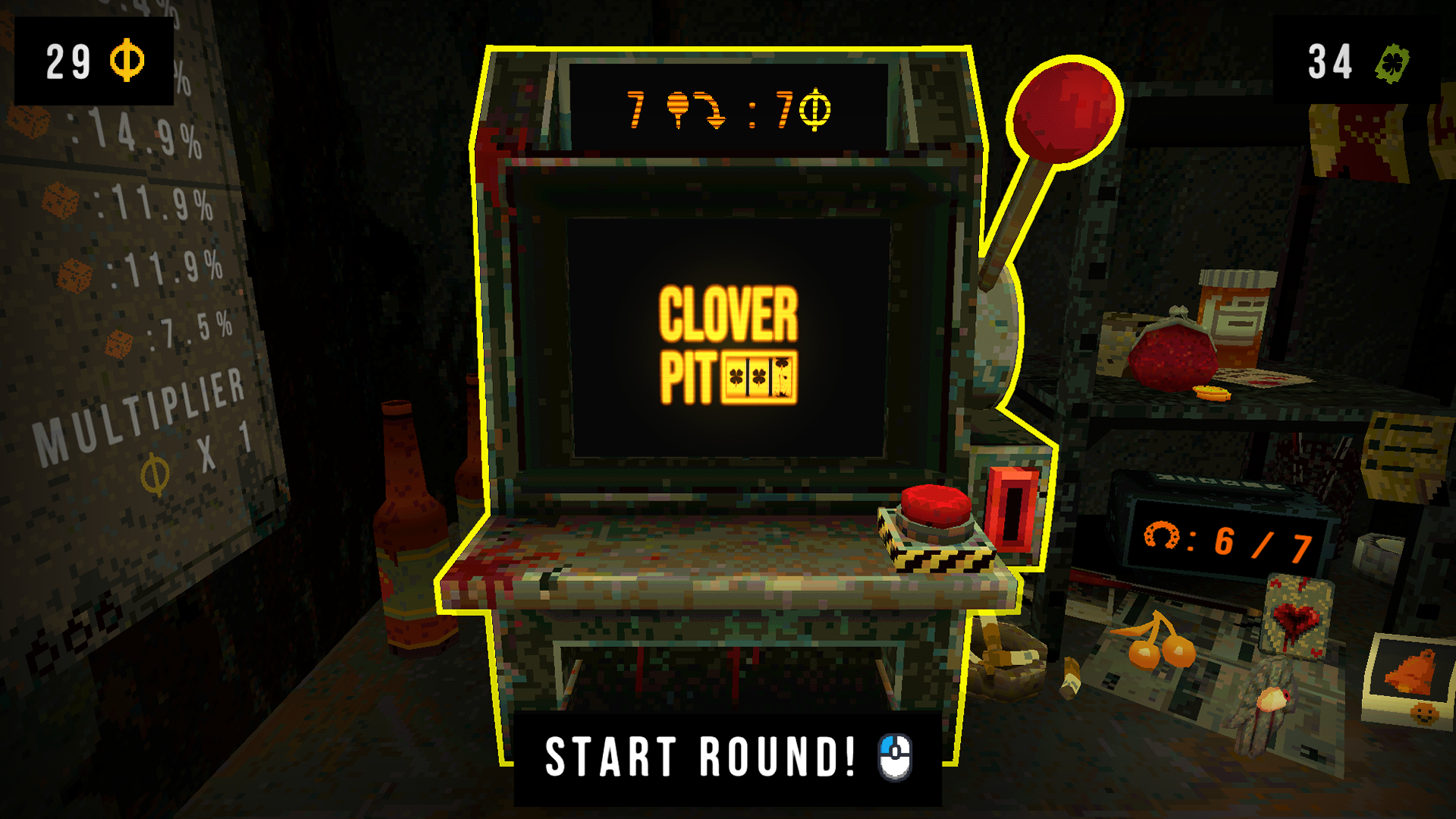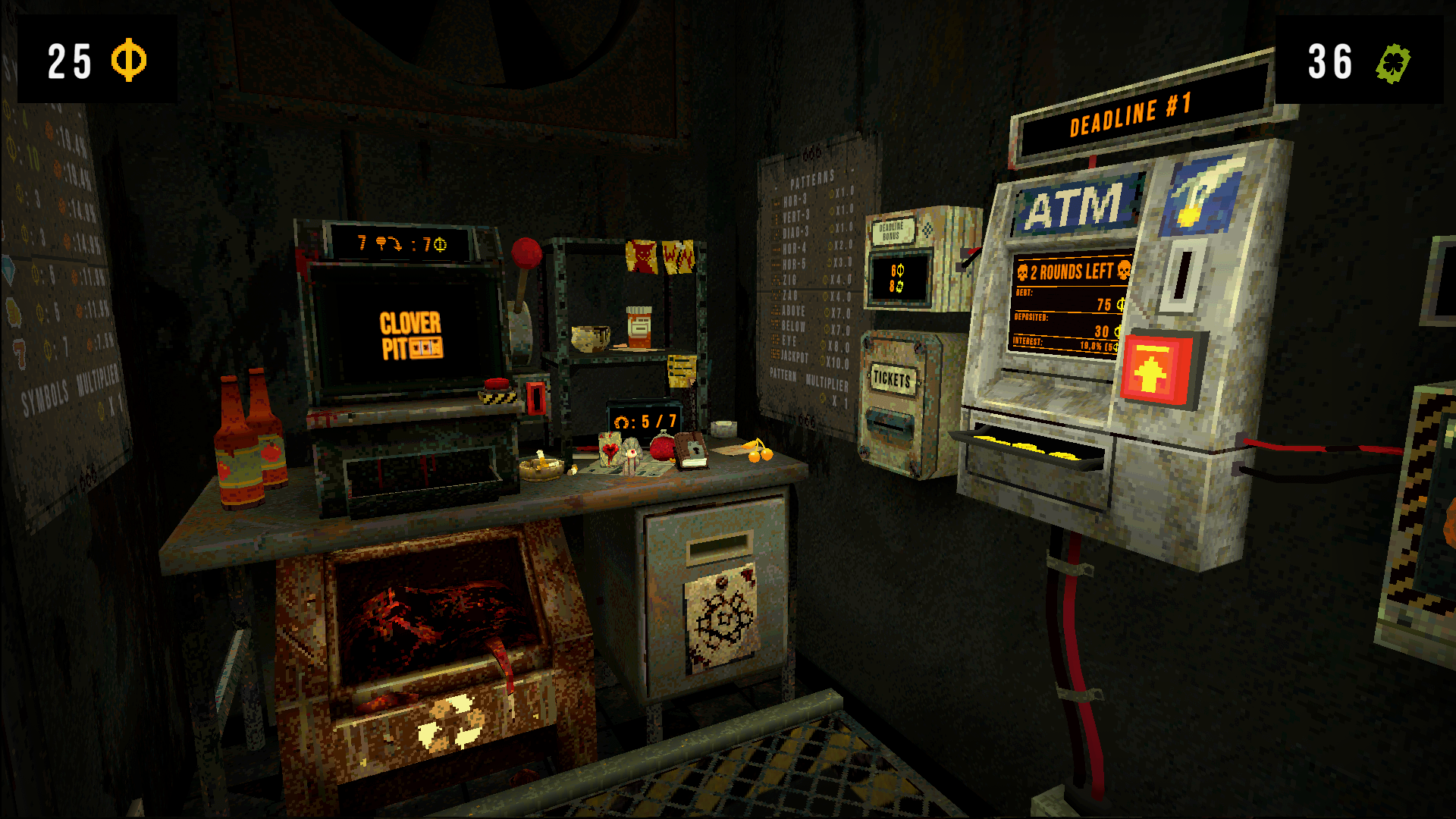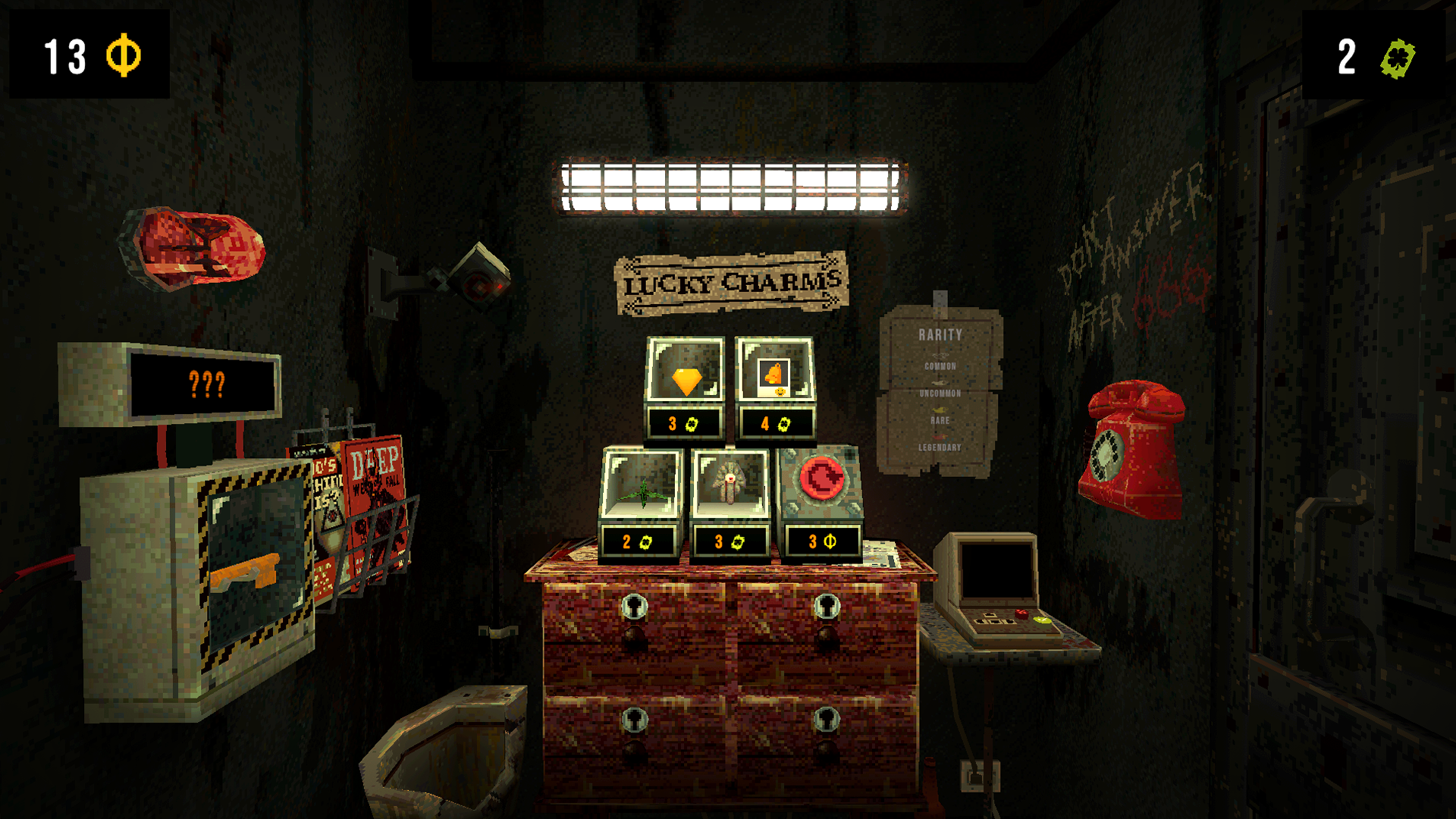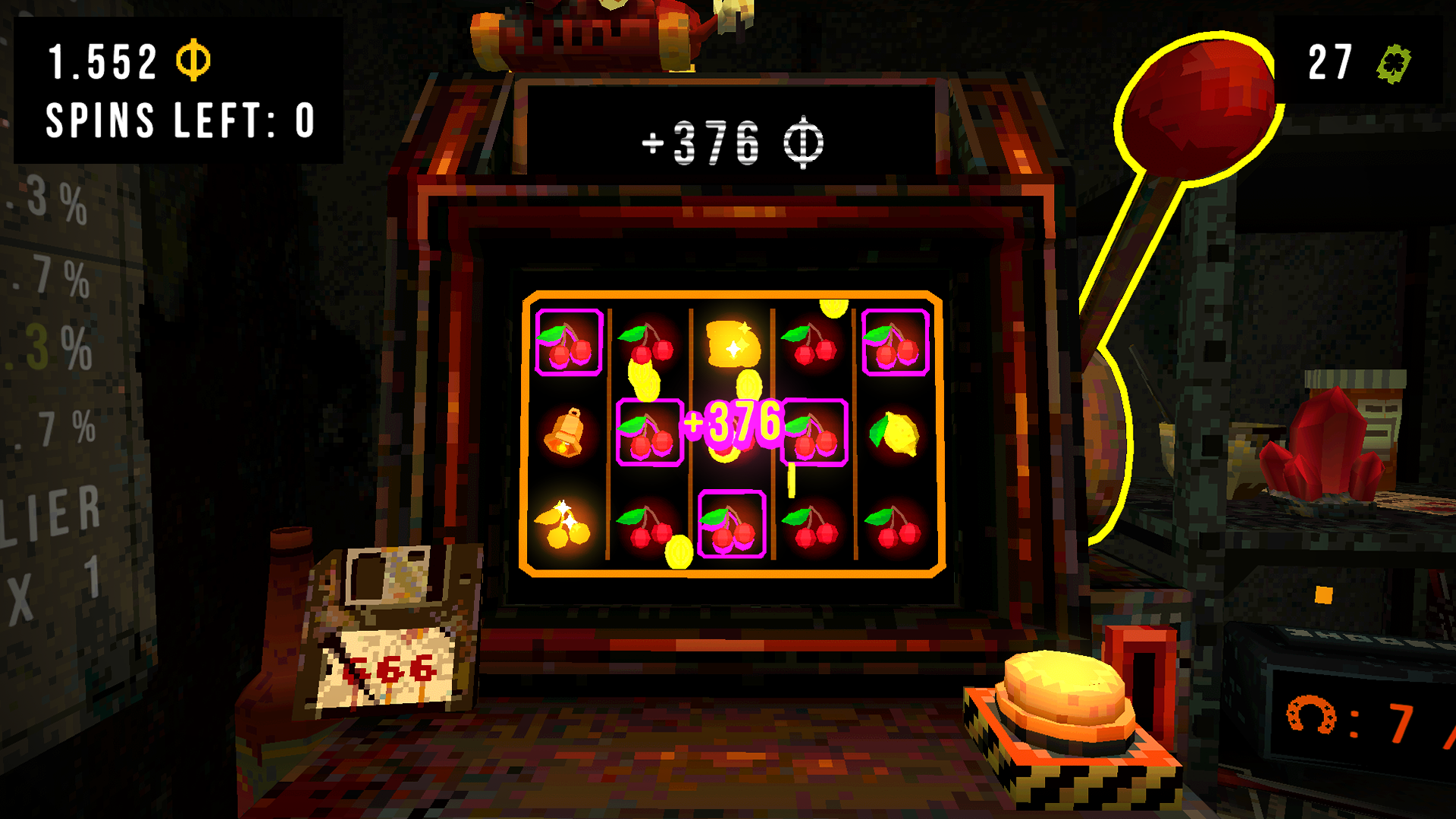
CloverPit slams you into a neon‑slick nightmare: a rusted cell, a blinking ATM, and a slot machine that’s equal parts salvation and sadistic puzzle. The loop is pure rogue‑lite alchemy; coax the slot into cooperating, stack items and charms to spark runaway combos, then gamble those gains to pay your crushing debt. Every spin is a tense calculation of risk versus reward; win enough and you edge toward freedom, fail and the escape you chased turns into something far darker and more final; watch the trailer here:
Core Themes
CloverPit marries an addiction allegory with gleefully exploitable systems; you don’t merely pull a lever, you learn to bend the slot to your will. Prize charms, stacked items, and emergent synergies turn scattered payouts into snowballing, screen‑clearing combos that feel equal parts discovery and discovery‑weapon. The tension is mechanical and moral; math, timing, and meta‑progression are as vital as luck; so every runaway win tastes thrilling and a little uneasy. It’s tense, grotesque, and delightfully chaotic: a “debt simulator” that rewards clever rule‑breaking while never letting you forget what you’re trying to escape.

What you do
• Locked in the pit: You begin each run trapped in a cramped, rusting cell with only a slot machine, an ATM, and the random scraps the game hands you. The setting is claustrophobic and immediate: every choice matters because there are no second chances.
• Spin to engineer fortune: Pull the lever to trigger prizes, then use pickups and charms to tilt the odds. Items can nudge symbols, duplicate payouts, or add conditional multipliers so the slot stops feeling like luck and starts feeling like a programmable engine for explosive gains.
• Build snowballing combos: Collect synergies that chain payouts into runaway sequences. Well-timed item interactions convert tiny wins into screen‑clearing jackpots, turning the slot into a creative puzzle where discovery and optimization produce dazzling victories.
• Risk versus cash‑out: Decide when to push for larger combos and when to bank your haul. Every extra spin risks wiping out a run; every safe cash‑out slows momentum. That push‑pull creates tense, breath‑held choices that define each playthrough.
• Debt and consequences: At the end of each round you must repay your debt. Meeting the target preserves your run and funds meta‑progression; failing doesn’t just end the session, it leads to literal ruin. The debt mechanic turns success into progression and failure into visceral loss.
• Layered progression loops: Runs feed into seeded attempts, permanent unlocks, and run modifiers. Unlockable items and modifiers reshape later runs, encouraging experimentation and offering ever‑bolder strategies to exploit the machine.

Core systems and hooks
• Slot machine as a programmable engine: The slot is deliberately broken from real‑world gambling conventions: it’s a sandboxed toy you learn to manipulate. Prizes, charms, and conditional effects let you rewrite payout logic, convert RNG into reliable returns, and chain outcomes into engineered explosions of value. The core joy is systemic discovery; spotting a strange interaction, exploiting it, and watching a “big big combo” steamroll the run.
• Deep item pool and emergent synergies: With 150+ items and permanent unlocks, CloverPit treats pickups as building blocks for emergent strategies. Items nudge symbol probabilities, duplicate or reroll payouts, spawn conditional multipliers, or introduce whole new mechanics that reframe how you spin. The result is near‑infinite experimentation; familiar items can behave wildly different once paired, and the best runs feel like improvised mathematics.
• Rogue‑lite scaffolding that rewards experimentation: Seeded runs, meta‑progression, and unlockable run modifiers provide both short bursts of intensity and meaningful long‑term goals. Permanent unlocks reshape later attempts, enabling higher‑risk gambits and new playstyles while keeping each fresh attempt impactful.
• Endless and competitive score play: Beyond the escape route, Endless Mode invites players to push a single run to absurd heights for leaderboard glory. It’s built for optimization addicts who enjoy squeezing every exploit from a system and chasing higher scores through carefully engineered combos.
• Tightly focused atmosphere and narrative stakes: The cramped cell, the blinking ATM, and the debt clock combine into an escape‑room‑like pressure cooker. Narrative beats lean sinister and allegorical: addiction, compulsion, and the moral cost of “winning” thread through gameplay, and multiple endings let your approach to risk and repayment shape the story’s conclusion.
• Design risks that pay off when tuned: The game’s premise depends on balance between breakability and fun. When synergies are tuned well, runs feel legendary; if left unchecked or poorly gated, some combos could trivialize the challenge. That tension is intentional and central to the design, the thrill comes from learning where the machine breaks in your favor and deciding whether to exploit it.

Tone, themes, and intent
CloverPit wears its horror like neon jewelry; a gleefully grotesque aesthetic that makes the grotesque feel alluring and the alluring feel dangerous. The game frames its mechanics as moral tests, each engineered jackpot is a small triumph that tastes increasingly bitter, so play is equal parts catharsis and cautionary tale. It’s horror‑adjacent rather than straight terror: you’re invited to break the system, revel in absurd combos, and then reckon with the corrosive thrill that drives you to push further. The developers are explicit and responsible about their intent: this is not real‑world gambling, but a deliberately breakable simulation built to be studied, abused, and ultimately overcome; one that asks players to enjoy the highs while staying mindful of the costs.

Why it stands out
• Concept clarity: CloverPit commits fully to a single, provocative metaphor: the slot machine is the game’s mechanical and thematic heart, not decoration. That singular focus makes every system and narrative beat feel coherent and purposeful.
• Synergy depth: Over 150 items and charms create an ecosystem of emergent combos; simple pickups can cascade into screen‑clearing explosions, rewarding experimentation, pattern recognition, and creative problem solving.
• Escape‑room pressure: The claustrophobic cell, ATM debt clock, and end‑of‑round repayment mechanic keep tension high; decisions carry immediate consequences, raising the stakes for every spin and strategic gamble.
• Layered replayability: Seeded runs, meta‑progression, and unlockable modifiers ensure variety across attempts; progression both empowers new strategies and invites riskier, more satisfying gambits as you learn the system.
• Clear design identity: The game’s aesthetic, mechanics, and narrative all pull in the same direction, giving CloverPit a memorable personality that helps it stand out among rogue‑lites.

Concerns and watch points
• Gambling imagery may alienate: The slot‑machine core is a deliberate thematic choice, but its gambling aesthetics and addiction allegory can be off‑putting for some players even though no real money is involved.
• Breakable systems risk unfun extremes: Designing a toy that’s meant to be broken is fragile: unchecked synergies can produce trivial, one‑shot escapes that remove challenge, while the opposite; stiff early pacing before key unlocks; can make runs feel unfairly punishing.
• Balance will need active stewardship: Maintaining fun across progression requires tight tuning of item drop rates, payout scaling, and debt thresholds; without regular adjustments some strategies could dominate or stagnate the meta.
• Tone divides audiences: The game’s sinister, satirical, claustrophobic voice won’t click for players seeking lighthearted or whimsical roguelikes; those expectations will clash with CloverPit’s darker intent.
• Replay fatigue is possible: The core loop is deep but narrow; players who prefer broad, exploratory roguelikes may find the slot‑first gameplay repetitive after extended sessions.
• Accessibility and clarity challenges: Highly emergent interactions can be opaque to new players; clear onboarding and UI feedback will be essential to help people understand why combos happen and how to plan around them.

Launch and community momentum
Released on September 26, 2025, from Panik Arcade (developer) and Future Friends Games (publisher), CloverPit landed with loud, playful momentum; half neon spectacle, half conversation starter. The studio leaned into that buzz, thanking a huge wishlist community and promoting launch bundles and the soundtrack to keep attention high. Since release the team has actively solicited forum feedback and committed to regular patches, balance passes, and quality‑of‑life updates; an essential posture for a game built around fragile, breakable systems that thrive when tuned and iterated.

Final Verdict
CloverPit is a brash, unnerving rogue‑lite that weaponizes a single, provocative idea; the slot machine; into an expansive playground of risk, invention, and moral tension. Its happiest moments are the ones you engineer: spotting an obscure interaction, chaining charms into absurd multipliers, and watching a run snowball into something legendary. Those highs come with a sour edge, though; the game constantly asks whether you’re mastering the machine or letting it master you. If you love dissecting brittle systems, optimizing emergent combos, and don’t shy from darker themes wrapped in neon, CloverPit deserves a spot on your radar. Try the demo, chase the combos, and see if you can cash out before the pit claims you.
Watch and Wishlist
• Wishlist CloverPit now: Get notified for discounts, bundles, and the full release.
• Play the demo: Test spins, feel the pacing, and see if the slot‑engine and synergies click for you.
• Follow Panik Arcade and Future Friends Games: Track patch notes, balance passes, and new items or modifiers.
• Enable store notifications: Turn on alerts for limited demos, launch bundles, and soundtrack drops.
• Watch trailers and streams: Gameplay clips reveal combo depth and pacing more clearly than screenshots; watch a few runs to judge whether the loop appeals.
• Consider launch bundles: Bundles with Balatro, Buckshot Roulette, and others can be a bargain if you like experimental rogue‑lites.
• Wishlist the soundtrack: If the demo’s audio sticks with you, following the OST signals interest to the devs.
• Leave constructive feedback on the forums: Devs are iterating; your reports on balance, clarity, and UX help shape future patches.
• Share with optimization communities: Streamers and theorycrafters love emergent combos, recommend the demo to anyone who enjoys breaking systems.
Key Takeaways
• Bold central idea: The slot machine is not window dressing; it’s the game’s mechanical and thematic core, turned into a programmable engine to bend and exploit.
• High‑risk, high‑reward loop: Every spin is a tense tradeoff: push for massive combos or cash out to survive the debt timer.
• Deep emergent systems: 150+ items and charms create layered synergies that reward experimentation, pattern recognition, and creative optimization.
• Strong atmosphere: The cramped cell, ATM, and debt mechanic create pressure and dread, giving runs real emotional weight.
• Replayability and goals: Seeded runs, meta‑progression, unlocks, and Endless Mode provide both short bursts and long‑term objectives.
• Moral edge: The game frames exploit-driven triumphs as bittersweet, turning fun mechanical mastery into a commentary on addiction and compulsion.
• Balance sensitivity: The design intentionally invites breakability, which is thrilling when tuned but risks trivializing challenge or creating punishing early runs without careful adjustments.
• Audience fit: A must‑try for players who love exploiting emergent systems and optimizing brittle engines; may be off‑putting for those sensitive to gambling imagery or preferring lighthearted roguelikes.
Game Information:
Developer:
Publisher:
Platforms: PC (reviewed)
Release Date: , 2025
Score: 9.0 / 10
CloverPit nails a daring premise and turns it into deeply satisfying gameplay: the slot machine isn’t a gimmick but a programmable engine you learn to exploit, and discovering a runaway combo feels genuinely euphoric. The game’s systems; 150+ items, seeded runs, meta unlocks, and an Endless leaderboard; reward experimentation and mastery, while the claustrophobic ATM/debt hook keeps stakes sharp and immediate. A few balancing wrinkles remain (some synergies can shortcut challenge, and the gambling motif will divide players), but those are minor against a design that consistently surprises, thrills, and resonates. For players who love emergent systems, high‑risk optimization, and roguelites with a darker edge, CloverPit is essential play.